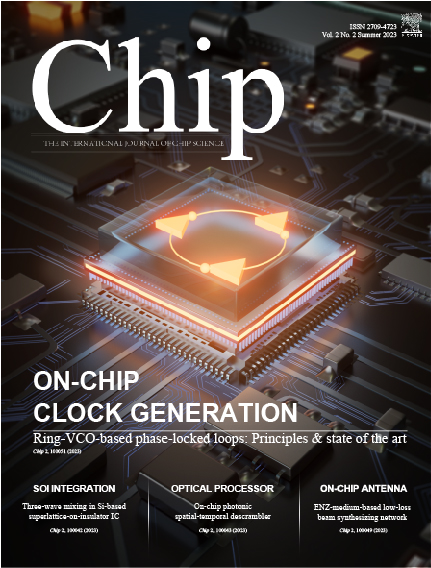 View fulltext
View fulltext
Photodetectors (PDs) are crucial in modern society as they enable the detection of a diverse range of light-based signals. With the exponential increase in their development, materials are being used to create a wide range of PDs that play critical roles in enabling various applications and technologies. Image sensor technology has been hindered due to the lack of a universal system that can integrate all types of PDs with silicon-based readout integrated circuits (ROICs). To address this issue, we conducted experiments adopting two-dimensional materials as an example. High-performance MoS2-/MoTe2-based PDs were fabricated in the current work and the most suitable ROICs were identified to pair with them. This established a solid foundation for further researches in the field of image sensors. We developed and implemented a versatile testing system that uses a printed circuit board to connect the PD and ROIC. After the ROIC generates the sampled signal, it is collected and processed by algorithms, which overcome device uniformity limitations and produce a high-quality image that is visible to the naked eye. This universal system can be used with a wide range of PD and ROIC types made from different materials, making it highly convenient for diverse testing applications and the development of diverse image sensor types. This robust new platform is expected to spur further innovation and advancements in this rapidly developing field.
In this article, a two-dimensional (2D) honeycomb lattice phononic crystal (PnC) based micro-oven with large bandgap is introduced to be integrated with piezoelectric microelectromechanical systems (MEMS) resonator to reduce anchor loss for timing applications. Finite element method (FEM) analysis and experimental measurement were performed to verify that the proposed PnC micro-oven design gives advantage in quality factor (Q). The measurement results demonstrate that the resonator with 2D honeycomb lattice PnC micro-oven shows a repeatable 1.7 times improvement of average Q compared with the bare one. The resonator with micro-oven control was further measured for frequency stability. The proposed piezoelectric micro-oven-controlled MEMS resonator achieves a frequency stability of less than ±10 ppb in a stable environment, which indicates promising potential for application in high-end timing field.
Research about singularities has been driving scientific advancements across mathematics and physics. Comprehending and harnessing the novel properties of singularities in photonics can facilitate the development of integrated micro-nano devices in diverse platforms. Herein, we provide a comprehensive overview of photonic singularities emerging in structured light fields and metamaterial structures. We classify them into several representative types: real-space singularities, momentum-space singularities, and parameter-space singularities, with discussions of their intriguing topological and dynamical properties. Moreover, we report on the latest applications of photonic singularities in broad areas, ranging from light routing, lasing, sensing, and optical manipulation to imaging and display. This review connects the singularity phenomena in different photonic systems, bridging the abstract concepts with emerging practical applications. It underscores the significance of photonic singularities in both fundamental science and various on-chip applications.
Modern computational technologies are gradually encountering significant limitations, driving a shift toward alternative paradigms such as optical computing. In this study, novel all-optical combinational logic units based on diffractive neural networks (D2NNs) were introduced, which were designed to perform high-order logical operations efficiently and swiftly with the adoption of only two modulation layers. This innovative design exhibits increased processing speed, improved energy efficiency, robust environmental stability, and high error tolerance, making it exceptionally well-suited for a broad spectrum of applications in optical computing and communications. By leveraging the transfer learning, we successfully developed a fifth-order cascaded combinational logic circuit for a practical information transmission system. Furthermore, we revealed a pioneering application of the device in optical time division multiplexing (OTDM), demonstrating its capability to manage high-speed data transfer seamlessly without the need for electronic conversion. Extensive simulations and experimental validations demonstrate the potential of the model as a foundational technology for future optical computing architectures, which paves the way toward more sustainable and efficient optical data processing platforms.
This work presents an integrated multi-quantum well (MQW) optoelectronic sensor leveraging III-nitride materials for multifunctionality on a monolithic chip. The sensor was fabricated using standard microfabrication techniques and adopted the identical InGaN/GaN MQWs, which enables simultaneous emission and detection. The sensor is featured with a double concentric circle structure which supports both on-chip and off-chip detection mechanisms, being capable of detecting environmental parameters like rotational speed, proximity, and sucrose concentration. It exhibits stable photocurrent response to rotational speed up to 8000 rpm, a 3 cm vertical detection range, and a linear response with 3.9 nA/% sensitivity to changes in sucrose concentration, which demonstrates the potential for diverse applications in industrial and biomedical fields.
Compared with the traditional frequency division duplex and time division duplex, the in-band full-duplex (IBFD) technology can double the spectrum utilization efficiency and information transmission rate. However, radio frequency (RF) self-interference remains a key issue to be resolved for the application of IBFD. The photonic RF self-interference cancellation (SIC) scheme is endowed with the advantages of wide bandwidth, high amplitude and time delay tuning precision, and immunity to electromagnetic interference. To meet the requirements of the new generation of mobile terminals and satellite payloads, the photonic RF SIC system is desired to be miniaturized, integrated, and low power consumption. In this study, the integrated photonic RF SIC scheme was proposed and demonstrated on a silicon-based platform. By utilizing the opposite bias points of the on-chip dual Mach-Zehnder modulators, the phase inversion relationship for SIC was realized over a broad frequency band. The time delay structure combining the optically switched waveguide and compact spiral waveguide enables continuous tuning of time over a wide bandwidth. The optical amplitude adjuster provides efficient amplitude control with a large dynamic range. After being packaged with optical, direct current, and RF design, the photonic RF SIC chip exhibits the interference cancellation capabilities across L, S, C, X, Ku, K, and Ka bands. In the S and C bands, a cancellation depth exceeding 20 dB was measured across a bandwidth of 4.8 GHz. An impressive cancellation depth of over 40 dB was achieved within a bandwidth of 80 MHz at a central frequency of 2 GHz. For the application of over-the-air IBFD communication at the newly promulgated center frequency of 6 GHz for 5G communication, the cancellation depth of 21.7 dB was demonstrated in the bandwidth of 100 MHz, and the low-power signals of interest were recovered successfully.
Featured with light emission and detection coexistence phenomenon, nitride-based multiple-quantum-well (MQW) diodes integrated chip has been proven to be an attractive structure for application prospects in various fields such as lighting, sensing, optical communication, and other fields. However, most of the recent reports are based on planar structures. Three-dimensional (3D) structures are endowed with extra advantages in direction, polarization, and absorption modulation and may pioneer a new way to make the same thing over and over again with interesting properties. In this paper, we designed and fabricated a single-cantilever InGaN/GaN MQW diode with warped 3D microstructure via standard microfabrication technology. Experimental results indicate that the strain architecture of the multi-layer materials is the key principle for the self-warped device. The planar structure will bear greater compressive stress while the warped beam part has less stress, which results in differences in the optical and electrical performance. The strain-induced band bending highly influences the emission and detection properties, while the warped structure will introduce direction selectivity to the 3D device. As an emitter, 3D structures exhibit a directional emission with lower turn-on voltage, higher capacitance, increased luminous intensity, higher external quantum efficiency (EQE), high –3 dB bandwidth, and redshifted peak wavelength. Besides, it can serve as an emitter for directional-related optical communication. As a receiver, 3D structures have lower dark-current, higher photocurrent, and red-shifted response spectrum and also show directional dependence. These findings not only deepen the understanding of the working principle of the single-cantilever GaN devices but also provide important references for device performance optimization and new applications in visible light communication (VLC) technology.
A versatile optoelectronic device with ultrasensitive negative-positive pressure sensing capabilities, which is integrated with a wireless monitoring system, was fabricated and demonstrated in the current work. The device comprises a monolithic GaN chip with a polydimethylsiloxane cavity and nanograting, which effectively transduces pressure stimuli into optical changes detected by the GaN chip. The developed device exhibits an ultra-low detection limit for a mass of 0.03 mg, a pressure of 2.94 Pa, and a water depth of 0.3 mm, with a detection range of -100 kPa to 30.5 kPa and high stability. The versatility of the device is demonstrated by its ability to monitor heart pulse, grip strength, and respiration. Its integration with a wireless data transmission system enables real-time monitoring of human activity and heart rate underwater, making it suitable for precise measurements in various practical applications.









